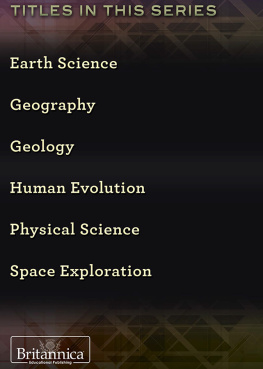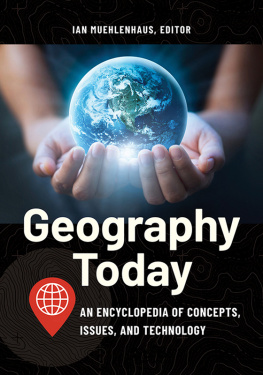ROUTLEDGE LIBRARY EDITIONS: SOCIAL AND CULTURAL GEOGRAPHY
Volume 11
THE SCOPE OF GEOGRAPHY
THE SCOPE OF GEOGRAPHY
Third Edition
RHOADS MURPHEY
First published in 1969 by Rand McNally
Second edition published in 1973 by Rand McNally
Third edition published in 1982 in the USA by Methuen & Co.
This edition first published in 2014
by Routledge
2 Park Square, Milton Park, Abingdon, Oxon, OX14 4RN
and by Routledge
711 Third Avenue, New York, NY 10017
Routledge is an imprint of the Taylor & Francis Group, an informa business
1969, 1973, 1982 Rhoads Murphey
All rights reserved. No part of this book may be reprinted or reproduced or utilised in any form or by any electronic, mechanical, or other means, now known or hereafter invented, including photocopying and recording, or in any information storage or retrieval system, without permission in writing from the publishers.
Trademark notice: Product or corporate names may be trademarks or registered trademarks, and are used only for identification and explanation without intent to infringe.
British Library Cataloguing in Publication Data
A catalogue record for this book is available from the British Library
ISBN: 978-0-415-83447-6 (Set)
eISBN: 978-1-315-84860-0 (Set)
ISBN: 978-0-415-73347-2 (Volume 11)
eISBN: 978-1-315-84833-4 (Volume 11)
Publishers Note
The publisher has gone to great lengths to ensure the quality of this reprint but points out that some imperfections in the original copies may be apparent.
Disclaimer
The publisher has made every effort to trace copyright holders and would welcome correspondence from those they have been unable to trace.
Rhoads Murphey
THE SCOPE OF GEOGRAPHY
Third Edition
Methuen
NEW YORK AND LONDON
First published in 1969 by Rand McNally
Second edition published in 1973 by Rand McNally
Third edition published in the USA by
Methuen & Co.
in association with Methuen, Inc.
733 Third Avenue, New York, NY 10017
Third edition first published in 1982 by
Methuen & Co. Ltd
11 New Fetter Lane, London EC4P 4EE
1969, 1973, 1982 Rhoads Murphey
Photoset by Nene Phototypesetters Ltd, Northampton and printed in the United States of America
All rights reserved. No part of this book may be reprinted or reproduced or utilized in any form or by any electronic, mechanical or other means, now known or hereafter invented, including photocopying and recording, or in any information storage or retrieval system, without permission in writing from the publishers.
Library of Congress Cataloging in Publication Data
Murphey, Rhoads, 1919
The scope of geography.
Includes bibliographies and index.
1. Geography. I. Title.
G116.M87 1982 910 826471
ISBN 0416334105 AACR2
British Library Cataloguing in Publication Data
Murphey, Rhoads
The scope of geography.
1. Geography
I. Title
910 G128
ISBN 0416334105
This book has grown out of an earlier book originally called An Introduction to Geography. The two have diverged through subsequent editions and each now deals quite differently with the field. The original Introduction, now called Patterns on the Earth and published by Houghton Mifflin in hard cover, is designed primarily for courses in regional geography, or for courses which introduce the student to the study of the field through the analysis of world regions. The Scope of Geography aims instead to provide an overall systematic view of the discipline of human geography as of the 1980s. It has been and remains a rapidly changing field, and the present edition incorporates those changes, presenting geography as a dynamic entity which addresses itself to the evolving problems of the modern world.
This new edition also provides greatly expanded cartographic coverage, with over twenty new maps, each keyed to the text and designed to enhance student understanding of the material and concepts introduced. Illustrative figures and diagrams have also been expanded and re-drawn, and several new ones added. In response both to changes within the field and to suggestions from many readers of earlier editions, the entire text has been re-worked, reorganized, and re-written, shortened and simplified in some sections, expanded in others, and with new material presented in every chapter. Revisions on nearly every page have corrected errors and made the material both current and clearer. Two entirely new chapters have been added, on Energy and Development and on Cities and Manufacturing, reflecting changes in the field, in the world with which it deals, and consequently in the needs of students and instructors in introductory geography courses.
While no one book can hope to meet exactly all the needs of every course or of every instructor, it is hoped that this third edition is now well suited for introductory courses in human geography. I have taught such courses myself for nearly thirty years and have learned a great deal, from my students, from colleagues in many places, and from comments on earlier editions of this book. I am grateful to all of them, and especially to those readers whose conscientious and thoughtful suggestions have contributed so much to this new edition. It is a pleasure also to thank Kathy Price and Monica Robinson for their cheerful and skillful work under pressure in preparing many of the new maps and figures.
Finally, I hope that the book may be useful also in a wider sense, as a survey of a field whose recent evolution makes it even more essential to all who are concerned about the world in which we live.
Rhoads Murphey
January, 1982
Geography comes from a Greek word meaning literally description of the earth. But modern geography is concerned with people as well as with the physical earth and with relationships and analysis as well as with description. Geographers analyze the physical landscape and examine relations between places in order to throw light on the pattern and nature of human society. They investigate the interrelationship which exists between people and their physical environment. They examine regional differences and attempt to account for them, pick out regional patterns, try to draw regional lines and to discern regional relationships. Geographers direct this study of the earth and its spatial framework, or the pattern of distribution of things on the earths surface, toward a better understanding of the human world. They set people and their culture in the framework of the world which they inhabit.
The broad outlook which is necessary when dealing with the analysis of spatial patterns over the world and of the varying regions and human use of the earth involves the geographer with a great number and variety of facts. By themselves, as separate individual pieces of information or simple descriptions of places and features, facts are less useful than if they can be related and where possible used to reach conclusions. Information is not the same as knowledge









